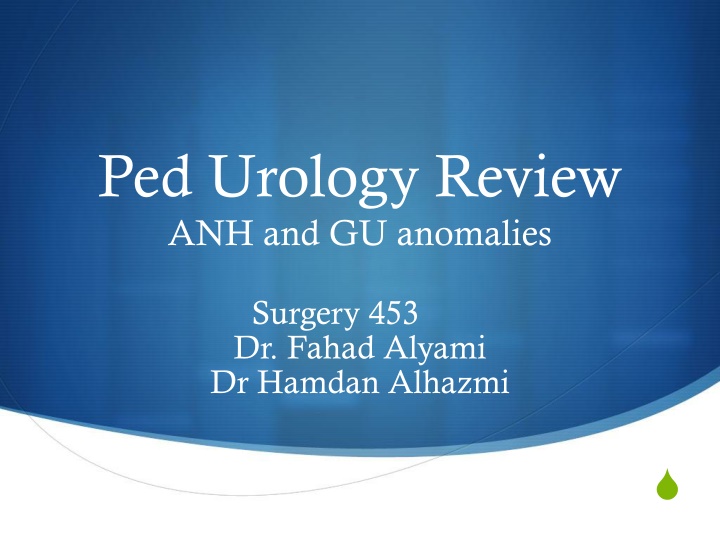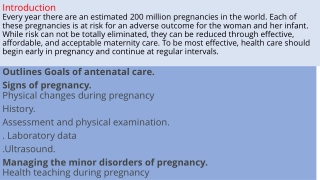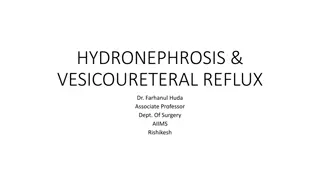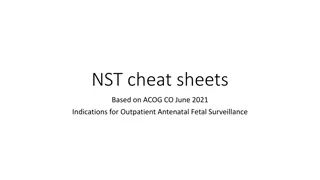Pediatric Urology Review: Antenatal Hydronephrosis and Genitourinary Anomalies
Pediatric Urology Review discussing antenatal hydronephrosis, bilateral vs. unilateral causes, postnatal evaluation and management, pre-natal ultrasound, oligohydramnios, investigations like US, VCUG, nuclear scan, and normal renal and bladder ultrasounds.
Download Presentation

Please find below an Image/Link to download the presentation.
The content on the website is provided AS IS for your information and personal use only. It may not be sold, licensed, or shared on other websites without obtaining consent from the author.If you encounter any issues during the download, it is possible that the publisher has removed the file from their server.
You are allowed to download the files provided on this website for personal or commercial use, subject to the condition that they are used lawfully. All files are the property of their respective owners.
The content on the website is provided AS IS for your information and personal use only. It may not be sold, licensed, or shared on other websites without obtaining consent from the author.
E N D
Presentation Transcript
Ped Urology Review ANH and GU anomalies Surgery 453 Dr. Fahad Alyami Dr Hamdan Alhazmi
Antenatal Hydronephrosis Def of hydronephrosis? Antenatal ?
You have 2 days old boy diagnosed bilateral hydronephrosis on antenatal US, what the possible causes? If this was unilateral , what are the possible causes?
POSTNATAL EVALUATION AND MANAGEMENT History Maternal health Maternal PMHx & FmHx: GU anomalies, course of pregnancy, DM, Meds Previous pregnancies: siblings w/ VUR, hydro Gender of the child Voiding ( 1stvoid , straining, wetting the diaper) EtOH, drug use
Pre-natal U/S Gender of fetus Single vs. multiple AF volume Kidneys: degree of hydro, variation in hydro b/w exams, unilateral/bilateral hydro. Ureters: hydroureter Bladder: presence, fullness, size, thickness, emptying Urethra: dilated posterior urethra Other abnormalities Overall growth and development
Oligohydramnios OLIGOHYDRAMNIOS = amniotic fluid <500cc (pocket <2cm) Before 16-18 wks, most of AF is a placental transudate By 20-22 wks, most of AF is fetal urine (urine production starts at ~12 wks) oligohydramnios that develops only after 18-20 weeks likely represents GU tract obstruction or abnormal renal development.
Investigations US VCUG Nuclear scan No IVP
Voiding cystourethrogram (VCUG)
No UPJ obstruction T1/2 R = 6 L = 2
Post natal workup Post-natal Observe child voiding. Serum Cr. (When and why?) Prophylactic antibiotic. Repeat US +/- VCUG or nuclear scan .
Divide your self in 3 teams , each team will be responsible for a case scenario.
Case 1 2 days old term boy (SVD), found to have bilateral hydronephrosis on antenatal US? What are the possible causes ? How would you manage this case?
Posterior urethral valve (PUV) congenital obstructive membrane in posterior urethra that impedes antegrade flow of urine. occurs in 1 in 8,000-25,000 live male births. ?
Initial Management of PUV 1ST step of management : Bladder drainage (permits medical stabilization) 1) Effective NICU support for issues with pulmonary hypoplasia & renal insufficiency 2) Lab investigations 3) - Electrolyte, creatinine , BUN: may take 48hrs to be accurate. Prophlactic Abx. 4) Cystoscopy and Valve ablation. (Definitive treatment) 5)
Case 2 5 days old boy with unilateral hydronephrosis diagnosed on antenatal US. What is the possible causes ? How would you approach this case?
RT LT
Rt UPJ obstruction T1/2 R = N/A
Ureteropelvic Junction Obstruction Most common cause of UNILATERAL hydro in fetal kidney (~50%) More common in Males, Lt> Rt.
Work-up No need for urgent intervention unless baby develops pyelonephritis (nephrostomy tube or stent). Repeat US. Diuretic renal scan ( MAG3 or DTPA)
Pyeloplasty Open/laparoscopic/Robotic
Case 3 5 days old girl fond to have bilateral hydronepohrosis on antenatal US? What are the possible causes? How would you approach this case?
Vesicoureteral Reflux (VUR) 30-40% of ANH is due to VUR. Presentation : ANH or UTIs. Family Hx (30%) .
Work-up for vur US VCUG.
Treatment options Observation Prophylactic antibiotics. Surgical: - Deflux injection - Ureteric reimplantation
Principles of Management of VUR Spontaneous resolution is very common 1. High-grade VUR is less likely to resolve spontaneously 2. Extended use of prophylactic ABx is benign 3. Success rate with surgical correction is very high 4.
Hypospadias What is hypospadias? Association of 3 anomalies of the penis Abnormal ventral opening of urethral meatus (glans to perineum) 1) 2) Abnormal ventral curvture. 3) Abnormal distribution of foreskin with a dorsal hood and deficient ventral foreskin
Hypospadias What is hypospadias? Association of 3 anomalies of the penis Abnormal ventral opening of urethral meatus (glans to perineum) 1) 2) Abnormal ventral curvture. 3) Abnormal distribution of foreskin with a dorsal hood and deficient ventral foreskin
Epidemiology Approximately 1 in 250 live male birth The majority are distal hypospadias. It can be familial. More in twins.
Diagnosis Most found at newborn P/E. Some cases are diagnosed at later age or after circumscion. Look for associated anomalies like UDT or intersex No routine imaging for isolated hypospadias.























